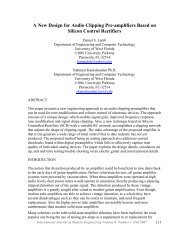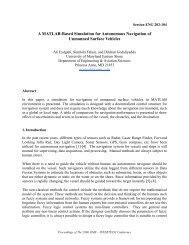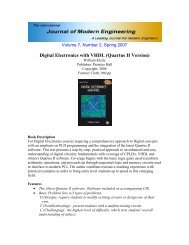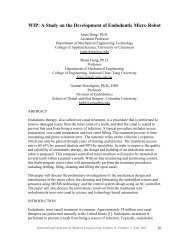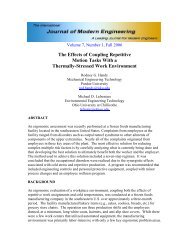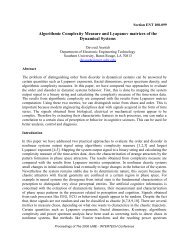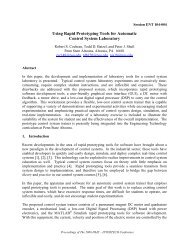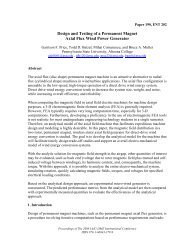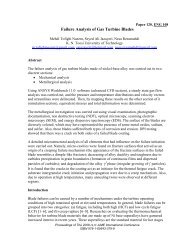Design and Analysis of Ultrasonic NDT Instrumentation ... - IJME
Design and Analysis of Ultrasonic NDT Instrumentation ... - IJME
Design and Analysis of Ultrasonic NDT Instrumentation ... - IJME
You also want an ePaper? Increase the reach of your titles
YUMPU automatically turns print PDFs into web optimized ePapers that Google loves.
——————————————————————————————————————————————–————<br />
Power consumption can vary for different functions <strong>and</strong><br />
scenarios. Power analysis on LRUT hardware for various<br />
scenarios <strong>and</strong> functionalities can enable one to specify an<br />
adequate power source for the instrumentation that would<br />
last for the scheduled inspection period. However, practical<br />
experimentation using hardware is not always possible at<br />
early stages <strong>of</strong> the project, nor is it feasible to run such experiments<br />
for all scenarios. Computer system modeling <strong>of</strong><br />
the LRUT system forms a virtual test platform that can be<br />
used for power analysis <strong>and</strong> optimization without the need<br />
for any hardware.<br />
System Modeling Concept<br />
Accurately modeling the inter-coupling nature between<br />
different engineering disciplines <strong>and</strong> simultaneously simulating<br />
the constructs on a single platform is crucial for underst<strong>and</strong>ing<br />
the system. There are high-end tools such as<br />
Saber <strong>and</strong> System-Vision from Cadence <strong>and</strong> Mentor<br />
graphics, respectively, which allow multi-engineering discipline<br />
systems to be modeled <strong>and</strong> simulated on a single platform,<br />
but they require specialized knowledge in all relevant<br />
engineering disciplines. The cost <strong>of</strong> licensing these tools is<br />
also high <strong>and</strong> disproportionate to most project costs. Computing<br />
power requirement is also intense.<br />
The LRUT System Model<br />
The simplified version <strong>of</strong> the LRUT system model using<br />
LTSpice is shown in Figure 2. It includes several constructs<br />
such as transmit circuit, transmit/receive transducer array<br />
(PZT_Array), test specimen (Pipeline) <strong>and</strong> receive circuit<br />
(Preamp). The system model represents a pulse-echo mode<br />
<strong>of</strong> operation. The pipeline was modeled using a lossy transmission<br />
line model. It has an integrated feature (e.g. defectweld<br />
– acoustic impedance mismatch) <strong>and</strong> the pipe end is<br />
terminated at an acoustic impedance equivalent to air. Each<br />
transducer in the transducer array is damped with a stainless<br />
steel backing block; more details are given in the load characterization<br />
section. This LRUT system model not only<br />
allows for analysis <strong>of</strong> the power performance <strong>of</strong> the system,<br />
but also allows port dynamics to be analyzed for signal<br />
strength.<br />
<strong>Ultrasonic</strong> piezoelectric transducers (lead-zirconatetitanate<br />
- PZT) are <strong>of</strong>ten used as transmit <strong>and</strong> receive sensors<br />
in LRUT techniques. The capacitive nature <strong>of</strong> these<br />
PZTs requires a high-voltage stress (excitation voltage) to<br />
force them into oscillation <strong>and</strong> to achieve a high signal-tonoise<br />
ratio. This high excitation voltage signal needs to be<br />
short (broadb<strong>and</strong>) in order to achieve better resolution [7-9].<br />
SPICE is a computer modeling language, which allows<br />
equivalent circuit models <strong>of</strong> different engineering disciplines<br />
to be modeled in the electronic domain. LTSpice is a<br />
free SPICE-based simulation tool developed by power product<br />
company Linear-Technology. It allows models to be<br />
inputted with their relevant parameters <strong>and</strong> simulated simultaneously<br />
on a single simulation platform. This method requires<br />
minimal knowledge <strong>of</strong> other secondary engineering<br />
disciplines, <strong>and</strong> simulation time <strong>and</strong> computing power are<br />
affordable, due to the simplistic algorithms <strong>and</strong> relaxed parameters.<br />
The LRUT system consists <strong>of</strong> multi-engineeringdiscipline<br />
constructs such as electrochemical (battery model),<br />
electromechanical (transducers - load) <strong>and</strong> analogdigital<br />
mixed-signal electrical components. SPICE-language<br />
-based equivalent circuit models have been developed for<br />
simulating foreign domain constructs in SPICE-based simulation<br />
tools [5], [6]. However, there is a trade <strong>of</strong>f in the accuracy<br />
<strong>of</strong> equivalent circuit model simulation results compared<br />
with the real system. Topology-specific models have<br />
been used in modeling work for power <strong>and</strong> functionally<br />
sensitive constructs. Presented here is the modeling <strong>and</strong><br />
related practical work carried out on the load, transmitcircuit<br />
<strong>and</strong> the high-voltage power supply in the associated<br />
system that has significant influence on power performance.<br />
Figure 2. Simplified LRUT System Model Constructed in<br />
LTSpice<br />
——————————————————————————————————————————————————-<br />
DESIGN AND ANALYSIS OF ULTRASONIC <strong>NDT</strong> INSTRUMENTATION THROUGH SYSTEM MODELING 89



